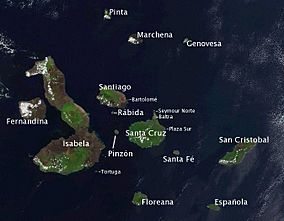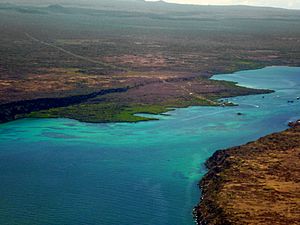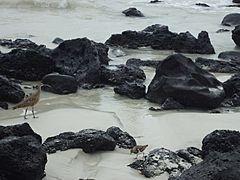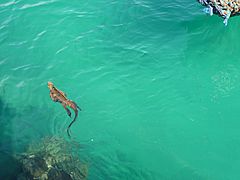Galápagos National Park facts for kids
Quick facts for kids Galápagos National Park |
|
|---|---|
|
IUCN Category II (National Park)
|
|

Satellite photo of the Galápagos islands overlaid with the Spanish names of the visible main islands.
|
|
| Location | Galápagos Islands |
| Area | 7995.4 km² |
| Established | 1959 |
Galápagos National Park (Spanish: Parque Nacional Galápagos) was created in 1959. It officially started working in 1968. This park was Ecuador's very first national park! It's also a special place recognized by UNESCO as a World Heritage Site. This means it's super important for everyone on Earth to protect.
Contents
Discovering Galápagos National Park
The government of Ecuador decided that 97% of the land on the Galápagos Islands would become a national park. The other 3% of the land is where people live. These areas are on islands like Santa Cruz, San Cristóbal, Baltra, Floreana, and Isabela.
Protecting the Islands
In 1971, the Galápagos National Park Service began with a Superintendent, two officers, and six park rangers. They worked on Santa Cruz Island. By 1974, the park had a plan to manage and protect the islands. The team grew to include a Superintendent, two conservation officers, and 40 park rangers. The Charles Darwin Research Station is also located on Santa Cruz Island.
In 1979, UNESCO named the Galápagos Islands a "Natural Heritage for Humanity." This made the Park Service even more responsible for protecting these amazing islands forever.
The Itabaca Channel
The picture on the left shows the Itabaca Channel. This channel is a waterway between two islands in the Galápagos. Baltra Island (also called South Seymour Island) is on the right side of the photo. Santa Cruz Island is on the left. Water taxis use the Itabaca Channel to take people from Baltra to Santa Cruz.
Protecting the Ocean
In 1986, the Galápagos Marine Reserve was created. This reserve helps protect the ocean around the islands. In the same year, the Galápagos National Park was also added to the list of Biosphere Reserves. This means it's a special place with unique plants and animals that should be saved for future generations to study and enjoy.
Exploring Tortuga Bay
One of the most popular places for visitors in the Galápagos is Tortuga Bay. It's on Santa Cruz Island. You can walk there from the main water taxi dock in Puerto Ayora. The walking path is about 2.5 kilometers (1.55 miles) long. It's open from six in the morning until six in the evening. Visitors need to sign in and out with the Galapagos Park Service office.
At Tortuga Bay, you can see amazing animals. Look for Marine iguanas, Galapagos crabs, and many different birds. They often rest on the lava rocks along the shore. There's also a special cove where you can swim. Here, you might see white tip reef sharks swimming in groups, small fish, and sometimes even the giant galápagos tortoise.
Gallery
- Protected wildlife and areas
-
School of scalloped hammerheads at Wolf Island in the Galapagos Islands
-
The marine iguana (Amblyrhynchus cristatus) Galápagos Islands Santa Cruz - swimming in Puerto Ayora
-
A breeding program in the Galapagos for Yellow Land Iguana living (pictured here living at the Charles Darwin Research Station, Puerto Ayora)
See also
 In Spanish: Parque nacional Galápagos para niños
In Spanish: Parque nacional Galápagos para niños
- The Life Cairn
- Charles Darwin







